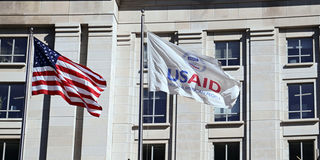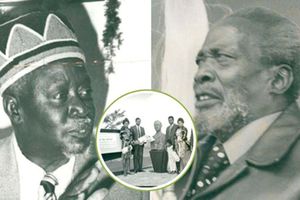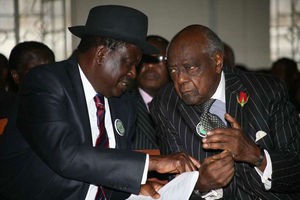
An American flag and USAID flag fly outside the USAID building in Washington, D.C., US, February 1, 2025.
Just after Kenya gained independence, Western powers used the United States Agency for International Development (USAID) to counteract and sabotage plans for a Soviet Union-sponsored technical college in Nairobi, according to previously restricted documents seen by the Weekly Review this week.
The college, together with other projects, had been negotiated for by the then Minister for Home Affairs Jaramogi Oginga Odinga during his visit to Moscow in May 1964 as a guest of President Nikita Khrushchev.
The American agency, whose activities are currently frozen by US President Donald Trump, had been created three years earlier to meet the needs of the developing countries, but also with the hidden motive of serving as a secret strategic tool in the fight against Soviet penetration during the Cold War. Prior to that, the US had been focusing its assistance on helping European countries that were reeling out of the effects of World War II. But as more countries in the third world achieved independence, there was a growing concern that they could easily fall to communism as the Soviet Union made spirited efforts to build its influence in these emergent nations.
It was against this backdrop that US President John F Kennedy signed into law the Foreign Assistance Act in 1961 to govern aid policy. It established USAID to lead the disbursement of aid and technical assistance to developing nations while secretly influencing them to align with the West. The Soviet Union was already deploying similar tactics by offering development projects to newly independent countries and supporting liberation struggles against colonialism. The Soviets’ argument was that communism was intrinsically a non-imperialistic, economic, and political ideology.
Cold War
Africa was quickly emerging as a theatre for these Cold War power plays as the winds of Black nationalism blew through many countries to independence. In the region, Kenya was particularly appealing to both the East and the West because of its strategic location.
While the West’s influence was already deeply entrenched after years of British colonisation, the Soviets were keen to penetrate and upstage the West by deploying aid diplomacy. In 1964, just after independence, Jaramogi, accompanied by Joseph Murumbi, made and extensive tour of China and Russia. He secured massive aid that sent shockwaves in the corridors of US State Department and British Foreign Office.
The Soviet’s aid included a gift of a 200-bed hospital built and staffed for free for two years; credit and technical assistance for a radio station, a technical school, textile, paper-making, fruit and fish canning factories. Chinese aid, on the other hand, included a free grant of $3,000,000 to help Kenya balance its budget and an interest-free loan of $15,000,000 for development projects, which was repayable over 10 years. The Soviets were also to provide 200 scholarships to Kenyans.
According to the declassified documents, when Jaramogi returned to Nairobi, he declared that the agreements reached were “quite good for a start and a solid foundation upon which continuous cooperation and mutual help in field of economic and cultural development will be built on our country.” But unbeknown to him, the American and British officials were already holding a flurry of meetings in Nairobi, Washington, and London to sabotage the agreements.
On May 22, 1964, the Director of Eastern and Southern African Affairs at the US State Department, Mr Jesse McKnight, summoned Sir John Killick, the head of the chancery, at the British Embassy in Washington to raise US concerns about Chinese and Russian offers to Kenya. According to a document marked “confidential” and dated May 23, 1964, during the meeting at the US State Department, McKnight complained that British officials were not doing enough to disparage and to counter the implications of the aid offered to Kenya by the East. He told the British diplomat that the first reports received by the US State Department indicated that the Commonwealth Relations Office in London and the British High Commission in Nairobi were “more relaxed,” and that the only action they had taken was to make a complaint in Nairobi about Jaramogi’s anti-British remarks in Beijing.
“The question which arose for policy decision was whether we should try to block the whole deal or parts of it and if so how; what projects the Western powers might offer to undertake and how they should be allocated. Mr McKnight said that his superiors in the US State Department tended to look to the United Kingdom to take the lead over this and to undertake the main burden,” the British diplomat reported to his seniors in London after the meeting.
Most dangerous
From the details of the meeting, the upper levels of the State Department were anxious to have a thorough assessment of the significance of the Soviet and Chinese aid not simply from the point of view of Kenya, but also on how they affected Western interests in the entire East Africa. United States Missions in Dare Salaam, Kampala, and Zanzibar were also requested to give their opinions on the new developments in Kenya.
The offer of a technical college in particular was seen by the State Department as the most dangerous of the Soviet offers to Kenya. As they say, ‘whoever has the power to disseminate information can significantly influence people’s thoughts and perspectives’, the State Department feared that allowing the Soviet Union in the education sector and in the media industry could enable them to build their influence and spread communism in Kenya.
In their offer of a technical college, the Soviet were to provide instructors and equipment, and Kenya was to provide a building for the college. One of the facilities targeted by Kenya for the new technical college was British Army’s Templar Barracks in Kahawa, Nairobi. The magnificent Templar Barracks had been constructed by the colonial government to accommodate British Army soldiers in 1960, but with independence coming sooner than anticipated, plans began to give it to Kenya as a gift.
On June 19, 1964, Murumbi, who had returned with Jaramogi from Moscow, visited the then-acting British High Commissioner to Kenya HSH Stanley and requested that Templar Barracks be made available for the new technical college. However, Stanley turned down the request by informing Murumbi that such a move would be very badly received in London. To further discourage Murumbi, Stanley stated that the idea of a “Russian technical college might provide useful training, but Russian instructors were bound to attempt political indoctrination.”
Stanley would later inform London that: “Murumbi said that Kenyans were determined not to let the Russians use the college for political purposes but he agreed that Russian instructors could hardly be stopped from extolling merits of the Communist way of life and drawing unfavourable comparisons with the west.”
Instead of a Soviet-sponsored technical college, the British wanted Templar to be turned into a teachers’ training college.
Stanley noted: “There is keen competition for Templar Barracks. We have been lobbying discreetly in favour of teacher training college.” That same year, the British transferred Templar Barracks to the Ministry of Education on condition that it became a teachers’ training college. On September 18, 1965, Templar Barracks was officially opened by Mzee Jomo Kenyatta as Kenyatta College to train teachers.
Meanwhile, as the search for a building to house a Soviet-sponsored technical college continued, in July 1964 a delegation of Russian government officials arrived in Kenya to discuss details of the implementation of the projects agreed upon in Moscow. On the question of a technical college, one team led by a Mr K. Chertkov headed to the Kenya Polytechnic in Nairobi, where a meeting had been arranged for them. However, when they arrived at the institution, they were shocked to find the people they were to hold discussions with were all British expatriates.
“No Africans were available to attend the meeting, so the Russian educational experts found themselves faced by three British expatriates, including the principal of the polytechnic, to discuss the technical college,” wrote B. Greatbatch.” The Russians were somewhat taken aback by meeting this phalanx of ‘imperialists’, and at first refused to open negotiations.”
Technical college
The Russian team demanded that at least an African official in the Ministry of Education or a politician had to be present. After a frantic search, an assistant minister was brought into the polytechnic, and the meeting kicked off. Following a lengthy discussion, the Russians then asked to be shown the building that had been promised to them for a technical college, but the British expatriates present stated as far as they were aware there was no building.
All along, the Russians had been sitting pretty believing that the polytechnic would be the site of the technical college, and were therefore upset to learn that this wasn’t the case. It appeared that British diplomats had connived with some pro-West officials in the Kenyatta government to sabotage the Soviet offer of a technical school.
Greatbatch wrote, “(Kenneth) Matiba, the Permanent Secretary, Education, told me he was ‘playing for time’ with the Russians.”
With the Soviet showing great determination in their push for a technical college, there was growing desperation among American and British officials to undercut them.
“What could this technical college do that the West could not and should not be doing?” asked McKnight of the US State Department. To thwart the idea, USAID was entrusted with carrying out investigations and to come up with an aid plan that would render the Russian offer of a technical college irrelevant to Kenyan officials. One of the proposals USAID came up with was to finance the extension of the Kenya Polytechnic to accommodate more students for technical courses. As one official stated, “If these extensions are carried out, there will be no possible justification for the Russian Technical College.”
Consequently, in August 1965, USAID signed a loan agreement with Kenya to provide $550,000 for the expansion of Kenya Polytechnic. The institution was to be expanded from 600 students to 1,300 students, with the number growing to 2,300 students in 1970. This exceeded by far the 1,000-capacity technical college the Soviets had proposed to build. The deal struck by Jaramogi had been sabotaged.







